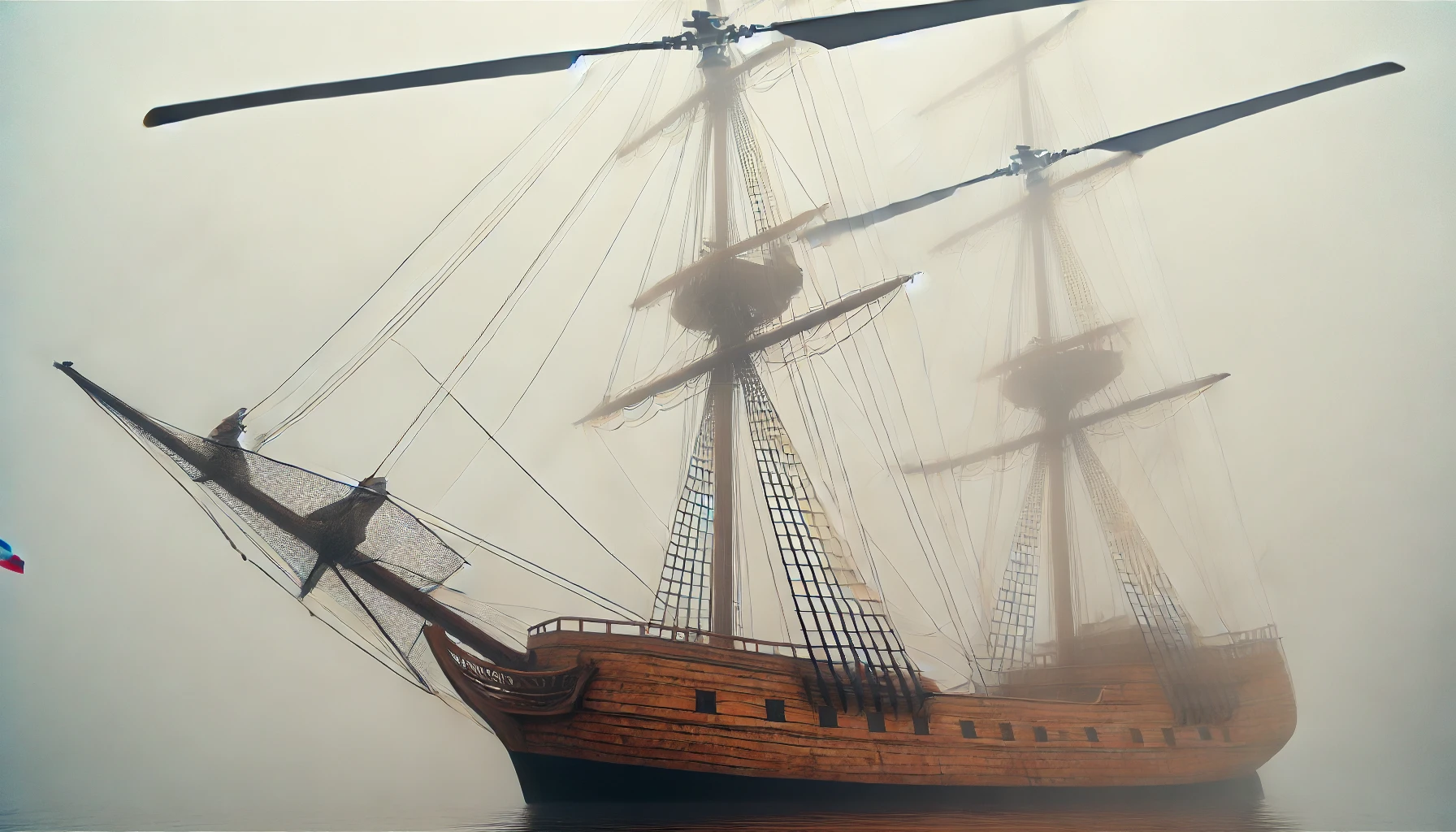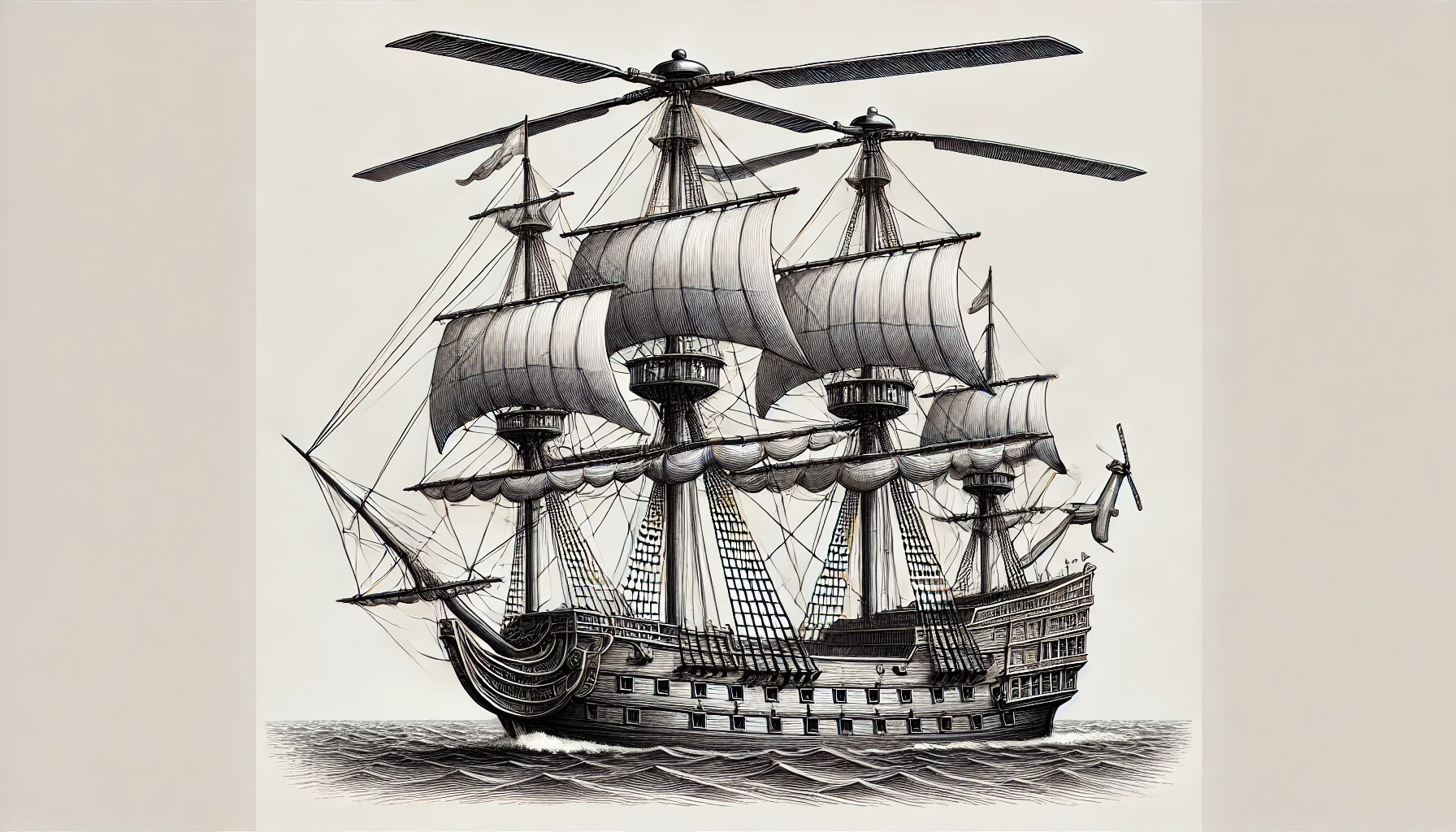Shtandart: wooden naval helicopter from the 18th century
An unusual “natural” phenomenon was observed by farmers in northern France in early June: in the evening, borscht rained down from the sky onto a field in the village of Sechville. Residents of the village claim that they saw a flying ship moving away into the fog. Looking ahead, I hasten to disappoint ufologists: this object was fully identified. It may seem absurd? But several people cannot collectively hallucinate at once. I decided to conduct my own investigation, as a result of which shocking details of the actions of the Russian special services were revealed.
But first things first.
 When I became aware of
this incident, I immediately went to the spot. Unfortunately, the recent
rains had washed away the borscht from the field, but local residents showed me a strange
artifact: a St. George’s ribbon hung on the branches of an apple tree. I talked to all the
eyewitnesses and they all claimed that they saw an old wooden ship with three masts. Monsieur
Dupont (real names have been changed to protect the participants in the investigation) reported
that when the ship flew over him, he clearly heard “Kalynka-malynka” being sung on board. I
have no reason not to believe him; according to Monsieur Dupont, his grandfather, a participant
in the Napoleonic War, sang this song to him. It was his grandfather who set fire to dilapidated
huts on the outskirts of Moscow on the orders of Napoleon himself. There is still some old
overcoat in the attic that smells like a burnt bear. Monsieur Pigeon said that strange pigeons
were discovered in his dovecote that did not respond to French commands and pooped only once a
day - at exactly noon Moscow time - and the feces were tricolored.
When I became aware of
this incident, I immediately went to the spot. Unfortunately, the recent
rains had washed away the borscht from the field, but local residents showed me a strange
artifact: a St. George’s ribbon hung on the branches of an apple tree. I talked to all the
eyewitnesses and they all claimed that they saw an old wooden ship with three masts. Monsieur
Dupont (real names have been changed to protect the participants in the investigation) reported
that when the ship flew over him, he clearly heard “Kalynka-malynka” being sung on board. I
have no reason not to believe him; according to Monsieur Dupont, his grandfather, a participant
in the Napoleonic War, sang this song to him. It was his grandfather who set fire to dilapidated
huts on the outskirts of Moscow on the orders of Napoleon himself. There is still some old
overcoat in the attic that smells like a burnt bear. Monsieur Pigeon said that strange pigeons
were discovered in his dovecote that did not respond to French commands and pooped only once a
day - at exactly noon Moscow time - and the feces were tricolored.
Then I realized that everything pointed to a Russian trail. I wondered how many similar Russian ships could now be in the waters of the European Union. I could only find one such ship: the frigate Standart. Everything was coming together.
I opened the MarineTraffic website to see where the ship was now, and to look at her navigation history. Frankly, I was quite surprised to see that at the beginning of June the ship entered Russian territorial waters, specifically approaching the port in St. Petersburg. At the same time, her AIS was turned off for a long period. Suspicious, isn't it? Even more suspicious was the fact that two hours earlier, the Shtandart was in the port of the Spanish city of Pasai San Pedro. How could she cover such a distance in such a short time? I had to answer this question.
Everything indicated that the ship was moving not by water, but by air: both her speed and eyewitness accounts supported this theory.
 Unexpectedly, the investigation
led me to Simferopol. A veteran of the trolleybus forces said
that at the end of the twentieth century, the drawings of the flying ship were stolen by Russian
special services from the Simferopol trolleybus shipyard. According to my source, the drawings
surprisingly resembled an early 18th-century engraving made by a French artist and currently
kept in the Louvre. Apparently, Jules Verne was inspired by this image when he wrote his book
“Robur the Conqueror”. It turned out that the technology had been known for a long time, and the
Russians only had to
build a ship. Which is what they did.
Unexpectedly, the investigation
led me to Simferopol. A veteran of the trolleybus forces said
that at the end of the twentieth century, the drawings of the flying ship were stolen by Russian
special services from the Simferopol trolleybus shipyard. According to my source, the drawings
surprisingly resembled an early 18th-century engraving made by a French artist and currently
kept in the Louvre. Apparently, Jules Verne was inspired by this image when he wrote his book
“Robur the Conqueror”. It turned out that the technology had been known for a long time, and the
Russians only had to
build a ship. Which is what they did.
 When the ship is in port,
anyone can notice that her sails are always retracted. This is
excellent camouflage for helicopter blades. That is why the crew did not allow one of the
participants in the demonstrations to climb onto the yards in Camaret-sur-Mer: the woman
undoubtedly had suspicions that she wanted to confirm.
Many visitors noticed that the ship has two powerful engines. Normally a ship of this size would
need a 500 HP engine, but here the engines are twice as powerful! Now it becomes crystal clear
that this is necessary not for moving through water, but through air. Monsieur Dupont complained
that when the ship flew past, the wind from the rotation of the blades tore off his tin foil
hat. According to Monsieur Dupont, at that moment he found himself defenseless against the
effects of psychotronic weapons from aboard the spy flying ship. The impact was so strong that
he immediately wanted to invade Belgium the next afternoon, and only a powerful slap in the face
from Madame Dupont made him abandon this idea.
When the ship is in port,
anyone can notice that her sails are always retracted. This is
excellent camouflage for helicopter blades. That is why the crew did not allow one of the
participants in the demonstrations to climb onto the yards in Camaret-sur-Mer: the woman
undoubtedly had suspicions that she wanted to confirm.
Many visitors noticed that the ship has two powerful engines. Normally a ship of this size would
need a 500 HP engine, but here the engines are twice as powerful! Now it becomes crystal clear
that this is necessary not for moving through water, but through air. Monsieur Dupont complained
that when the ship flew past, the wind from the rotation of the blades tore off his tin foil
hat. According to Monsieur Dupont, at that moment he found himself defenseless against the
effects of psychotronic weapons from aboard the spy flying ship. The impact was so strong that
he immediately wanted to invade Belgium the next afternoon, and only a powerful slap in the face
from Madame Dupont made him abandon this idea.
Why did neither NATO nor Eurocontrol respond to the flying object? I have an answer to this question as well. The thing is that the ship is built of wood and remains invisible to the radars of air traffic control services. Apparently, when landing in the Gulf of Finland, the crew had to turn on AIS to avoid being hit by Russian air defense.
Not long ago, the captain of the ship joked that the Shtandart would now be like the Flying Dutchman, moving from port to port. Was he joking?
 Unfortunately, we
cannot ban the presence of the Shtandart in EU airspace because the sanctions do
not prohibit replicas of flying wooden ships. However, I would like to point out that the ship
violated at least one very important law. There is not a single EASA-certified pilot among the
ship's crew. Therefore, I call on the European Commission to immediately ban Shtandart's flights
in EU airspace, at least until they have a certified naval aviation pilot on board.
Unfortunately, we
cannot ban the presence of the Shtandart in EU airspace because the sanctions do
not prohibit replicas of flying wooden ships. However, I would like to point out that the ship
violated at least one very important law. There is not a single EASA-certified pilot among the
ship's crew. Therefore, I call on the European Commission to immediately ban Shtandart's flights
in EU airspace, at least until they have a certified naval aviation pilot on board.
By the way, about naval aviation: undoubtedly, the construction of a wooden flying helicopter ship is a response to France’s refusal to sell helicopter carriers to the Putin regime. This is how the idea of combining a ship and a helicopter to create the perfect spy weapon, invisible to radar, came about.
